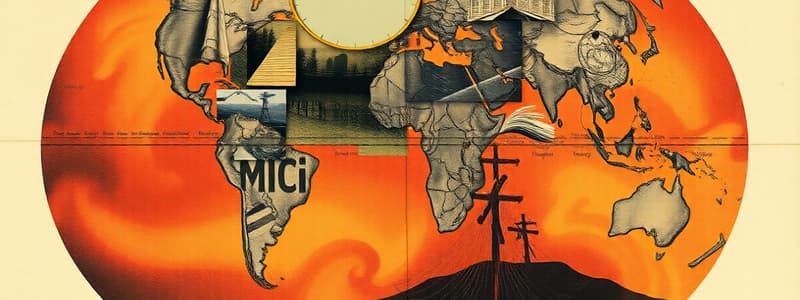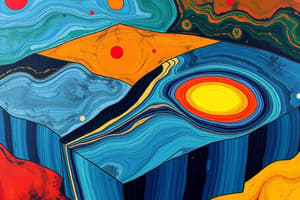Podcast
Questions and Answers
What is the outermost layer of the Earth composed of?
What is the outermost layer of the Earth composed of?
- Tectonic plates (correct)
- The Mantle
- The Core
- Magma
What is a 'fault' in the context of earthquakes?
What is a 'fault' in the context of earthquakes?
- The point where earthquakes originate
- A type of seismic wave
- A measurement of earthquake strength
- Where two tectonic plates meet (correct)
What is the primary cause of earthquakes?
What is the primary cause of earthquakes?
- Meteorite impacts
- Sudden slipping of tectonic plates (correct)
- Underground explosions
- Volcanic eruptions
According to the elastic rebound theory, what causes the ground to shake during an earthquake?
According to the elastic rebound theory, what causes the ground to shake during an earthquake?
Which area is known as the 'Ring of Fire'?
Which area is known as the 'Ring of Fire'?
What percentage of the world's earthquakes occur in the Ring of Fire?
What percentage of the world's earthquakes occur in the Ring of Fire?
Which tectonic plates are connected by the Alpide Belt?
Which tectonic plates are connected by the Alpide Belt?
What is the location on Earth's surface directly above where an earthquake originates called?
What is the location on Earth's surface directly above where an earthquake originates called?
What is one potential consequence of underwater earthquakes?
What is one potential consequence of underwater earthquakes?
Besides the slipping of tectonic plates, which of the following can also cause earthquakes?
Besides the slipping of tectonic plates, which of the following can also cause earthquakes?
Flashcards
Lithosphere
Lithosphere
The Earth's outermost layer, composed of large slabs of rock.
Tectonic Plates
Tectonic Plates
Large slabs of rock that make up the lithosphere and fit together to create the Earth's crust.
Fault
Fault
A place where two tectonic plates meet.
Cause of Earthquakes
Cause of Earthquakes
Signup and view all the flashcards
Elastic Rebound Theory
Elastic Rebound Theory
Signup and view all the flashcards
Ring of Fire
Ring of Fire
Signup and view all the flashcards
Alpide Belt
Alpide Belt
Signup and view all the flashcards
Focus
Focus
Signup and view all the flashcards
Epicenter
Epicenter
Signup and view all the flashcards
Tsunamis
Tsunamis
Signup and view all the flashcards
Study Notes
- The Earth's lithosphere consists of large rock slabs called tectonic plates, which fit together to form the Earth's crust.
- Faults are formed where two tectonic plates meet.
- Earthquakes are dangerous events triggered by sudden plate movements along faults, releasing energy in the form of waves.
- The shaking caused by these waves can damage homes and businesses.
Main Cause of Earthquakes
- The primary cause is the abrupt slippage of Earth's tectonic plates beneath the surface.
- Tectonic plates move due to their position atop a fluid layer of convection currents deep underground.
- Friction arises when the motion of plates brings them together.
- Continuous pressure from convection currents leads to the plates slipping when the pressure overcomes the friction.
- The sudden slip releases energy and tension, resulting in an earthquake.
Elastic Rebound Theory
- The buildup of tension when stretching a rubber band.
- The release of all the tension in the form of energy when the rubber band snaps.
- The elastic rebound theory explains that ground shaking occurs due to energy released from a fault slip.
Earthquake Zones
- Certain global regions are more prone to earthquakes due to frequent tectonic plate movement.
- Scientists analyze past earthquake data to forecast potential future events.
Ring of Fire
- It is a U-shaped zone along the Pacific Ocean coast, spanning over 24,900 miles.
- It connects many tectonic plates including the Pacific, Indian-Australia, Philippine, Eurasian, North American, Cocos, Nazca, Antarctic, Caribbean, and South American plates.
- Plate movement in the Ring of Fire accounts for over 81% of the world's earthquakes.
Alpide Belt
- The Alpide Belt traverses southern Eurasia.
- It accounts for over 17% of global earthquakes.
- It links the Eurasian, Arabian, Indian, African, and Australian plates.
- Pressure from these plates has formed the Alps and the Himalayas.
Oceanic Ridge Belt
- It is also known as the Mid-Atlantic Ridge.
- It lies between the North American, Eurasian, African, and South American plates.
- It is a divergent boundary where tectonic plates move apart.
- Locations near the epicenter, such as Iceland, experience strong earthquakes from this zone, even though the focus point is underwater.
Earthquake Events
- Earthquakes originate underground at the focus, where tectonic plates meet.
- Strong waves radiate outward to the Earth's surface.
- The epicenter is the point on the Earth's surface directly above the focus.
- The strongest waves can cause significant damage near the epicenter.
- Underwater earthquakes can cause tsunamis, generating destructive waves that impact nearby land.
Other Causes of Earthquakes
- Underground explosions such as nuclear explosions which are on a smaller scale.
- Collapses of large rocks which causes a shift in the Earth's crust, which can cause earthquakes.
- Volcanoes - Movement of lava beneath the surface leads to shifts in the crust, causing mild earthquakes.
Studying That Suits You
Use AI to generate personalized quizzes and flashcards to suit your learning preferences.



